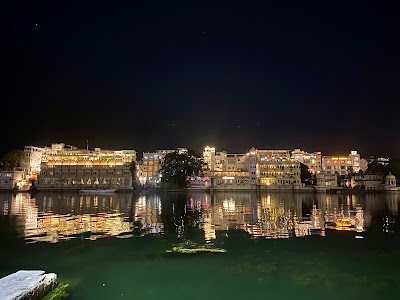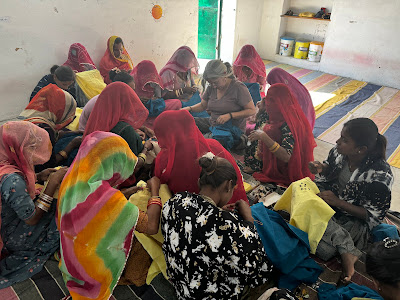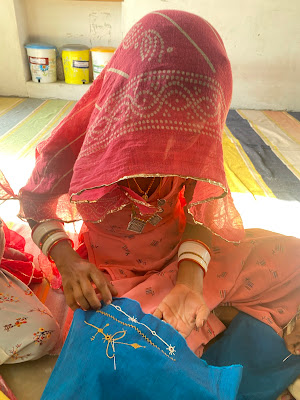Mt. Abu is the only hill station in Rajasthan and has been a place of great historical, spiritual, and artistic importance, as well as a desirable destination during the British occupation. Alan's father and uncle studied at the St. Lawrence school, located in Mt. Abu, whose facilities now belong to the police.
Alan's father and his brother lived at this school for 9 of the 12 months of the year and traveled by train to get there. The chances of our visiting the place were limited, since its now being a police training academy, it seemed unlikely to be possible to gain entry, especially considering the country's bureaucracy. However, there we were, embarking on a game of patience and diplomacy. It took us only 1 hour and 30 minutes to reach the director's office, passing through three previous checkpoints, the last of which involved a 1-hour interview covering questions about the reason for our visit, our origin, our relationship with history, and discussions about the practices and customs of Colombia and India. We then moved on to the interview with the director, which took only 45 minutes; the first 5 were formal, and the following focused on the tourist and cultural value, including instructions on how to prepare paratha, the traditional breakfast, which we had already found to work very well. Finally, our access to the main facade of the building and photographs for memory was authorised. The entire process and bureaucracy were fascinating, and sharing the mental space with Alan's father was an intrinsically beautiful exercise.
We explored the temples of the place, a beautiful display of Jainism, carved in marble and hand-painted in vibrant colours. We also visited the nature reserve and its scenic trail, observing the vast landscape and the layer of smog covering the land in all directions.
We continued our journey to explore the Jain Temple of Ranakpur, one of the most important and magnificent structures of Jain architecture. This temple, built in the 16th century, is noted for its intricate sculptures and marble carvings, featuring more than a thousand columns, each with a unique design, making it a true testament to the art and devotion of the Jain community.
Kumbhalgarh Fort, located in the state of Rajasthan, India, is a majestic fortress that rises amidst hills covered in vegetation. Built in the 15th century by King Rana Kumbha, this stronghold is famous for its extensive walls, which stretch approximately 36 kilometres and are considered the second longest in the world, after the Great Wall of China. The fort combines elements of Hindu and military design and is a great example of the rich history of the Rajputs in the area.
We headed south to visit Udaipur. Exploring small villages, suddenly a giant statue of Shiva caught our attention. When we say "giant," we refer to a structure 112 metres tall, made of steel and concrete, with a brass surface, bathed in zinc and bronze, called the Statue of Faith, located in Nadhdwara. We arrived expecting to find a ceremonial and worship space but discovered more of a meeting and entertainment centre with options and alternatives for everyone.
In Udaipur, the White City, we arrived in the land of the Mewar Kingdom, one of the oldest and most emblematic kingdoms in the country, with a history dating back to the 6th century, and which remained independent until the establishment of the republic in 1947. Founded by the Sisodia dynasty, Mewar was known for its valour and resilience against invasions, especially during the era of the sultanates and the Mughal Empire, and established a mutual respect agreement during the British occupation.
Udaipur served as the capital of the kingdom, and here one can enjoy the grandeur of its architecture around Lake Pichola. The royal palace is a complex of 11 buildings which combines Rajput and Muslim styles, with intricate details in its peacock mosaics and marble. The streets of Udaipur are adorned with white-painted houses and vibrant bazaars, where local crafts and textiles can be found.
The lake system of Udaipur is an impressive collection of bodies of water that has developed over the centuries, showcasing exceptional hydraulic engineering and a deep respect for nature. This system, which consists of a series of interconnected lakes, allows for the collection of rainwater and, in turn, balances the reserves among them, ensuring the conservation of the aquatic ecosystem and the availability of water for the various villages in the region, a key element for development in a semi-arid environment. Owing to its importance, the lakes and the development of the surrounding villages enhance the richness of the landscape.
In Barmer, we had met a textile entrepreneur from this city, so, just as we promised, we visited her. Alka Sharma is a textile designer, who graduated from the Indian Institute of Handicrafts and Design. In 2008, she conceptualised and founded Aavaran Udaipur, with the intention of reviving and sustaining the traditional practice of Dabu, a manual printing technique using wooden blocks and clay, as well as the traditional indigo dyeing techniques from Akola. With her, we were able to go through the entire process, from design to sale, and appreciate the beauty of the techniques at each stage, which was as satisfying as the intimate and close conversation with Alka.
We also visited an artisan village in Shilpgram, northeast of the city. There we delighted in various craft manifestations and the approach to rural life: music, dance, and art, as well as the extensive expression of Warli art, an ancient form of expression that dates back to 10 BCE, with a simple colour palette, often white on terracotta, used to decorate the earthen walls of houses. Its shapes are simple and highly representative and are always connected to nature and rural life, honouring Mother Nature.
Our visit to Udaipur ended with a massage that relieved our fatigue and tension, allowing us to enjoy, deep into the night, a sitar concert at one of the local music stores. It couldn’t have been better.
Alan & Marce



































